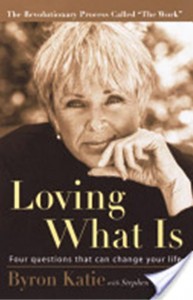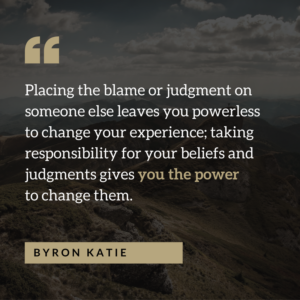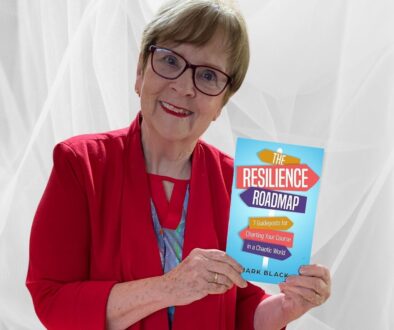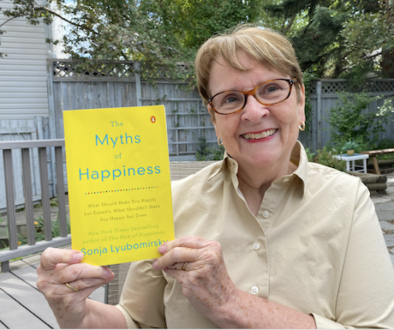Loving What Is by Byron Katie – Book Summary
 The work of Byron Katie is fascinating, often misunderstood and has helped hundreds, if not thousands of people through her seminars and book, Loving What Is.
The work of Byron Katie is fascinating, often misunderstood and has helped hundreds, if not thousands of people through her seminars and book, Loving What Is.
Overview:
In 1986, Byron Katie found herself in a residential treatment house for an eating disorder. There she had an awakening. Some might describe her experience as a spiritual transformation or a shamanic healing or a rebirth. Regardless, the definition of her new awareness, when she returned home, her husband and children noted a difference—a loving, grounded and wise difference. She was now in a place of loving what is and people started coming to Katie for guidance and advice. In Loving What Is: Four Questions that can change your life, Katie presents the following ideas and much more!

Basic Concepts of Loving What Is
- Our thoughts are often in-congruent with reality, that is, what is.
- Thoughts and stories repeated over and over again become unconscious beliefs.
- Learning what is right for your life is your job–not thinking or deciding what is right for others.
- You are neither your thoughts nor your stories.
- Notice your painful thoughts with interest and compassion.
- Distressful and painful feelings come from accepting untrue stories and thoughts.
- Write out your thoughts and stories. It is easier to challenge unconscious notions when they can be seen in black and white.
Katie offers the following four questions to challenge your thoughts:
- Is it true?
- Can you absolutely know that it’s true?
- How do you react when you think that thought?
- Who would you be without the thought?
Later in the process Katie gives more questions to challenge your thought (your story). She calls these questions turn arounds. A turn around is a way to explore what actually might be true for you. It encourages you to see the situation as a mirror to yourself
Turn the thought AROUND.
Example of a thought (story) He hurt me.
Turn it around to the OPPOSITE. He didn’t hurt me.
Turn it around to the SELF. I hurt me.
Turn it around to the OTHER. I hurt him.
Byron Katie Quotes:
- “As long as you think that the cause of your problem is out there, as long as you think that anyone or anything is responsible for your suffering, the situation is hopeless. It means that you are forever in the role of victim–that you’re suffering in paradise.”
- “A thought is harmless unless we believe it. It’s not our thoughts, but our attachment to our thoughts, that causes suffering. Attaching to a thought means believing that it’s true, without inquiring. A belief is a thought that we’ve been attaching to, often for years.”
- “I have never experienced a stressful feeling that wasn’t caused by attaching to an untrue thought. Behind every uncomfortable feeling, there’s a thought that isn’t true for us.”
- “Placing the blame or judgment on someone else leaves you powerless to change your experience; taking responsibility for your beliefs and judgments gives you the power to change them.”
- “We try to change our stressful feelings by looking outside ourselves. We try to change someone else, or we reach for sex, food, alcohol, drugs, or money in order to find temporary comfort and the illusion of control.”
- “Inquiry is about realizing that all the answers we ever need are always available inside us.”
- “When you argue with reality, you lose, but only 100% of the time.”
- “The only time we suffer is when we believe a thought that argues with what is.”
- “Life is simple. Everything happens for you, not to you. Everything happens at exactly the right moment, neither too soon nor too late.”
- “It’s not your job to like me—it’s mine.”
A word of caution:
Some academics argue that Katie’s approach can oversimplify complex psychological issues such as grief and trauma. I tend to agree. Although her system can help many people challenge their unhelpful thought patterns, many other people require a more research informed and trauma informed approach.
Conclusion:
Katie has presented around the world in such environments such as churches, universities, and prisons. She challenges her followers to question what they believe, what they are told from others and what they tell themselves.
Begin with catching moments when you can love what is and expand it. Also notice when you find it challenging to love what is. With practice you will at least move to accepting what is with the support of Loving What Is.
Please check out these related posts:
- Negative Beliefs: How to Identify and Replace Them
- Return to Center: Simple Strategies to Navigate Distress. . .




